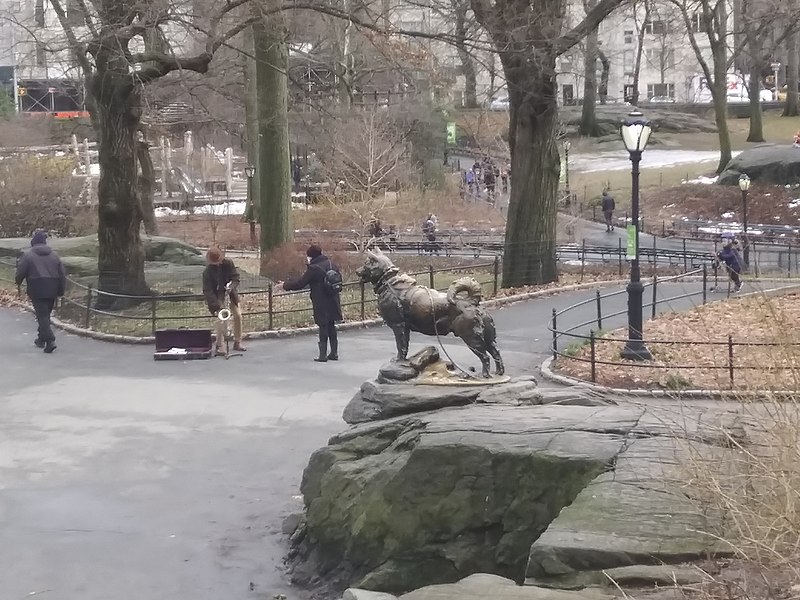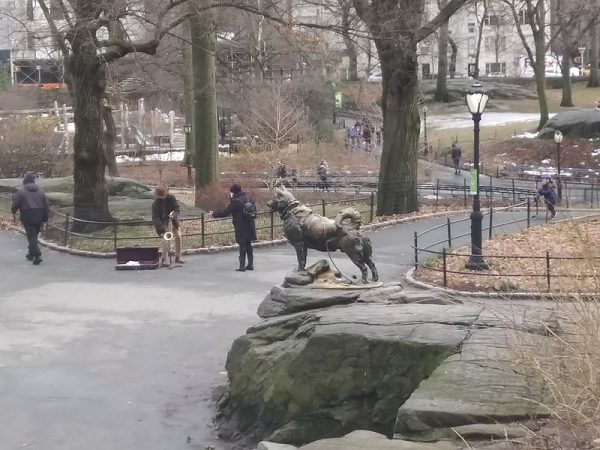One of the most famous statues in Central Park, in the heart of New York City, is the iconic Husky Balto. Central Park is actually home to more than 50 unique sculptures and dozens of works of art. So why is the Balto statue so beloved and so famous? Why is there a statue of Balto in Central Park at all? New York is a long way from Alaska, where Balto made his name. The history of the Balto statue is brief yet heartwarming. Balto makes an appearance in the Big Apple because, in 1925, Balto was the most famous dog in the world. Let’s learn more about the history of the Balto statue in Central Park, including who Balto was and why he was so famous.
The Nome Diphtheria Outbreak (1925)
In January 1925, the small town of Nome, Alaska, was in the midst of a dangerous outbreak of the disease diphtheria. Even to this day, Nome is a small and isolated community located hundreds of miles north of Anchorage. This isolation was only more pronounced a century ago. Diphtheria is a bacterial infection caused by Corynebacterium diphtheriae, and it can be fatal to children. Corynebacterium diphtheriae is dangerous because, during its normal lifecycle, it creates a toxin that poisons the infected person. To treat diphtheria, a shipment of vital antitoxin had to be shipped from Anchorage to help save the children of Nome.
The problem was that the antitoxin was nearly 700 miles away across a frigid wilderness. There were no good roads, and there were no bush planes yet buzzing around the Alaskan frontier. Instead, a team of sled dogs had to run the medicine from Anchorage, trading off throughout the journey, dragging a sled full of the medication over hundreds of miles through blinding snow, freezing wind, and temperatures that were as low as -50˚F.
Balto, the hardy Siberian Husky, was the lead dog of the team that finally pulled the medicine into Nome. He was only one of dozens of sled dogs that made the trek, but he was the face and the dog that led the team into Nome. The trip from Anchorage to Nome was followed by millions of people around the world. The progress and the health of the children of Nome were regular features of the daily newspaper and radio shows across the United States. The tale, the effort, and the heroism on display enthralled people for days.
When Balto triumphantly entered Nome, he instantly became a global hero. Balto was the physical embodiment of a dog’s bond to man, the limits that dogs could go to when pushed, and he was good-looking to boot.
The Statue Is Born (1925)
As soon as the Nome incident was resolved, Balto captured the imaginations of hundreds of people worldwide. One such person was New York sculptor and native Frederick George Richard Roth. Frederick Roth was a famous sculptor who did great work in bronze. After the Nome incident, Roth was approached by a group of artists led by Cecilia Beaux, who offered to pay Roth to make his vision of Balto a reality. The artist group felt strongly that a Balto statue should be placed in Central Park to be viewed and admired by millions. Roth set out to create a statue of Balto to commemorate the historic event and the dog himself shortly after the events in January.
The statue was unveiled in December 1925, less than a year after Balto’s heroic efforts in Alaska. At the unveiling ceremony, Balto himself was in attendance. Balto was one of the only known dogs in history to be able to see a statue of himself unveiled in such a public way.
The statue is engraved with a plaque that reads:
Dedicated to the indomitable spirit of the sled dogs that relayed antitoxin six hundred miles over rough ice, across treacherous waters, through Arctic blizzards from Nenana to the relief of stricken Nome in the Winter of 1925.
ENDURANCE FIDELITY INTELLIGENCE
The Balto statue was placed on a large granite rock amidst an outcropping of stone. The rugged stones and heroic pose help embody the vision and view of Balto as an Arctic savior.
The Statue Today
The Balto statue still stands triumphantly in Central Park today, just west of the intersection of 5th Avenue and E 67th Street. It is one of the most popular statues in the park. Despite competing with four dozen other statues, Balto continues to stand above the rest. The Balto statue is located near the entrance of the Tisch Children’s Zoo, making it very popular with children. Kids love to climb on Balto’s back and hold onto his ears. You can see the loving wear and patina on the Balto statue, which are a result of a hundred years of love.
The real Balto died in 1933, and his body currently resides in the Cleveland Museum of Natural History. Balto has continued to fascinate the imagination. Balto has inspired numerous books and movies since the events of 1925, which in turn fuels continued interest in the Central Park statue.

Conclusion
The Balto statue remains one of the most enduring and popular statues in Central Park. It was created by the famous sculptor Frederick Roth and remains a popular tourist attraction for visitors and local children. A century ago, Balto made a name for himself by pulling much-needed medicine hundreds of miles through ice, sleet, snow, and frozen water to save a group of isolated children. That legacy remains encased in bronze in New York City today as a testament to endurance, fidelity, and intelligence.
Featured Image Credit: Balto statue, view looking east from the East Drive, Jay Dobkin, Wikimedia Commons CC SA 4.0 International











